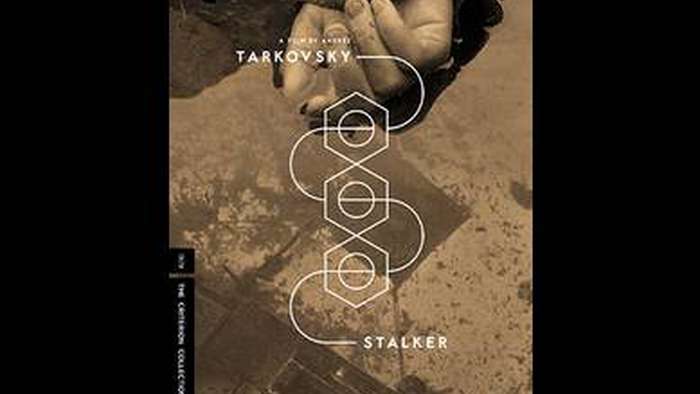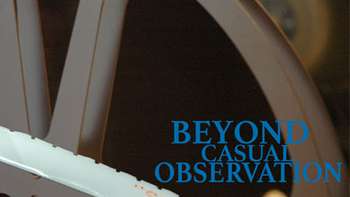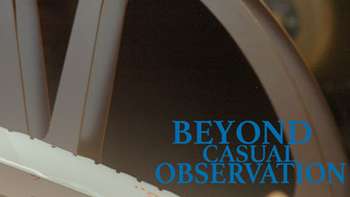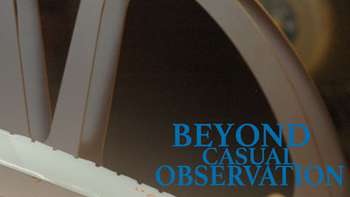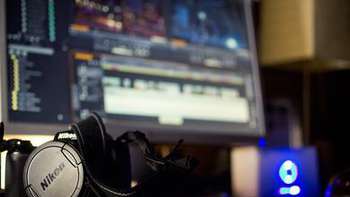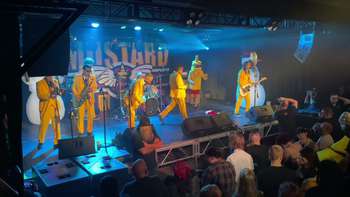Jeffrey Roy is busy. Check the link for his credits and you will see a vast list of projects. In this edition of “Beyond Casual Observation,” as with other entries, I talk to Roy to help round out the roles that audio professionals have in film. The similarities in sound for music and film extend beyond the software. Each have aspects that work cooperatively to solve problems in either industry, and it's always interesting to hear how these lines blur, or where the carry over is between the two fields of work. We get into his development in the entertainment industry and some of his preferred music as well. Thanks to Jeffrey Roy for giving incredibly thorough answers.
Scene Point Blank: Talk about being an ADR mixer and what components of sound you find yourself manipulating a lot in ADR.
Jeffrey Roy: As an ADR mixer, it is my job to engineer an ADR (Automated Dialog Replacement) session from top to bottom. While some bigger post-production houses often run two-person teams (a mixer and recordist), I work as a one man show 100 percent of the time in my current role. For those unfamiliar with the term, the process of ADR involves having an actor come back into the studio to re-record lines of dialog in sync to picture. This can be done for technical, performance or story reasons. ADR is an incredibly challenging process to get right -- in the end, we don't want anyone watching the film or TV show to know their was ADR, so our job is best done if we remain (the audio equivalent of) invisible to the viewer.
During a session, it is my duty to make microphone choices to closely match the production audio that was recorded on the day. We commonly record using a shotgun microphone (featuring a very directional pickup pattern, which you'll often see suspended overhead from a boom pole on set), and a radio mic, or lavalier (worn by the actors on their body). While we often times find ourselves needing to re-record entire scenes, sometimes it can be a single line that must be replaced. This can often be harder, as the line needs to match both technically and performance wise to sit seamlessly between the A and B sides of the production recordings. I will run the session using Pro Tools, the general standard DAW (digital audio workstation) software for our industry, handling recording of the lines at a proper level, and adjusting headphone mixes to anyone involved, be it an actor, producer, director, etc. An ADR mixer definitely needs to be able to multi-task, and make changes on the fly at a moments notice. Even with a ton of preparation before the session, each actor will have their own distinct workflow they prefer, and it is your job to accommodate them, not the other way around.
ADR is recorded in a fairly acoustically "dead" space, one devoid of what we call early reflections. With these recordings, the re-recording mixer can then process (compress, equalize, etc) the lines and send them to synthetic reverb or delay plug-ins to simulate a space (a hall, church, parking garage, etc). However, the biggest key to good ADR is performance. A line can have the most immaculate recording quality, but with the wrong performance, not even the best of the best will be able to make it sit properly. We often direct actors on timing, pitch, timbre, projection, and physicality (actually moving around in the booth if the line requires it, as opposed to standing still). The more authenticity to the read, the better. I was wowed in a recent session when an actress grabbed the nearby stool and wrestled with it to simulate her struggles with a character on screen -- and it worked wonders!
Scene Point Blank: Why should filmmakers and producers find room in their budget for sound?
Jeffrey Roy: Well, before budgeting for ADR, a filmmaker should focus on achieving the best production sound they can on the day. Take the time to listen to and accommodate your production mixer -- don't disregard his advice. On the day, you might not want to "waste time" with an extra 10 minutes on a setup when you just figure you'll fix it in post, but when that time comes, hindsight is always 20-20. Do whatever you can to get it on the day, as best you can, even if involves some tedium. ADR is not only difficult, but it's expensive. It can be a challenge for even the best actors to get back into the headspace they had on set when inside a recording booths months after they've wrapped and moved on from the character, so you don't want to rely on future ADR as a crutch when making decisions on set.
That said, once you reach post, sometimes ADR just can't be avoided. ADR can make the difference between a so-so sounding production, and a fully professional and seamless soundtrack where you don't risk your viewer focusing on anything but the story. ADR is something that many people dread or fear in the moviemaking process -- if I had a nickel for every actor who said "I hate ADR," I'd be a very rich man. But dialog is such a vital part of a film's soundtrack and storytelling, and certainly not the area you want to cut corners in. Take your time, do it right, and you can make the scene shine.
"There's just something about the soundtrack of a film that has always excited and intrigued me. Maybe because there are so many little nuances and roles to fill that your average filmgoer has no idea even exist."
Scene Point Blank: Where does ADR fit in the process/workflow of sound in post?
Jeffrey Roy: ADR is most commonly near the final stretch of the post process, but it can vary depending on the scope and budget of the project. Usually, once the edit of the film/TV episode is "locked" (locked being a running joke in post, as you'll often see Locked V2, Locked V3, etc), it is handed off to the sound team to assess the production (on set recording) dialog of each scene. The ADR or dialog supervisor/editor will make a list of all lines needing to be looped for technical reasons, and the director/producer will usually provide their own list of cues to be done for performance-based reasons, or new lines to be added that were never there in the first place (You learn to pick these out, often when a character is offscreen or the camera is on the back of their head -- try and unhear it!). If it is required in the delivery list, TV safe lines will also be recorded.
Some bigger projects may have actors in for multiple recording sessions over the course of the post production process, perhaps as the director is experimenting with performance choices and using ADR to determine decisions in the cut. Certain films may need to have this done for the sheer volume of cues (the Lord of the Rings trilogy is almost entirely ADR from top to bottom), and nobody wants a burnt out actor at the mic recording important lines. But, for your average project, the actor will be booked to come into the studio for a single session to record the sum of their cues, often as the project is readying for final mix.
Scene Point Blank: What motivated you to go into sound/post out of the various disciplines of filmmaking?
Jeffrey Roy: I graduated high school at 17 (having been skipped ahead a year from 1st to 2nd grade), and decided to use this "spare" year to work full-time and figure out what to do next. I landed a job at Future Shop (now defunct, at the time Canada's largest electronics retailer) in the entertainment department, dealing with movies, music, games and software. Every new release Tuesday, I would finish my shift and head to the register with a new pile of movies to buy -- my spending was admittedly out of control! I also used my staff discount to buy a 52" rear projection TV and my first home surround system. If I recall, it was a Harmon Kardon AVR130 and the Athena Micra 6 satellite and subwoofer package. Suddenly experiencing movies at home in 5.1 surround, as opposed to standard stereo from my TV, only fueled my movie obsession.
The moment I remember most was the day Spider-Man 2, my favorite film of all-time, came out on DVD in 2004. I purchased the 2-disc gift set, as well as the Superbit (of course), and rushed home to watch it. During the climactic train fight, there is an amazing change in perspective as Spidey is knocked down onto the side of the train. We cut to see him clinging to one train along the right side of the screen as a passing train on the left barely misses him. You experience this in the mix by the left train panning from the left front speaker to the left surround. Something about this just lit up a part of my brain, and from then on I was researching more and more about film sound, and it all snowballed from there. It took me a while to realize this might actually be something I could do as a career. After taking some classes locally, I was finally able to save enough to attend Full Sail University in 2011 and get my Recording Arts Bachelors.
There's just something about the soundtrack of a film that has always excited and intrigued me. Maybe because there are so many little nuances and roles to fill that your average filmgoer has no idea even exist. It's fun to be behind that curtain and help create something dynamic and exciting for the viewing audience to experience.
Scene Point Blank: Tell our readers about a movie that stands out for its overall excellence in sound.
Jeffrey Roy: Oh geez, how much time do you have? Well, aside from Spider-Man 2, a few of my favorite mixes/editorial pieces are:
- Black Swan: incredible sound design. Her final transformation into the Black Swan is chill inducing to me every time.
- The Incredible Hulk (2008): a staggeringly powerful mix. The blu-ray I always used to demo my home setup (back when I had one). The college campus fight is pure reference material.
- The Strangers: Listening to this mix upmixed to 7.1 and try not to be freaked out. Incredible use of the surrounds to create a sense of dread.
- Transformers (2007): Big and powerful, with some super fun uses of low end. My go to when I bumped up to dual 12" subs at home.
- The Haunting: The DVD used to be a known subwoofer killer. I haven't heard the blu-ray, but I'd assume it's even more lethal -- view with caution!
- Mad Max: Fury Road: When I got out of the theater seeing this one, I made a Facebook post saying "forget the rest of the year, we already have our Oscar winner for sound right here." Called it! Massive and bombastic, aggressive and tight. Also tons of ADR that all plays really well.
Scene Point Blank: Do you listen to a lot of music and if so what are some bands you like?
Jeffrey Roy: Tons! My favorite bands are Jimmy Eat World and the Dixie Chicks. Others include Nine Inch Nails, Muse, Vuvuvultures, Marianas Trench, Machine Gun Kelly, and Paramore. I also love film scores, favorites including the original Spider-Man Trilogy, Mad Max: Fury Road, Quantum of Solace, Spectre and Skyfall, The Social Network, and Star Wars.
Thank you to Jeffrey Roy for taking the time to answer these questions. The insight we get from professionals is illuminating, and my favorite part of writing BCO.
Follow Roy on Twitter @jeffroy87
